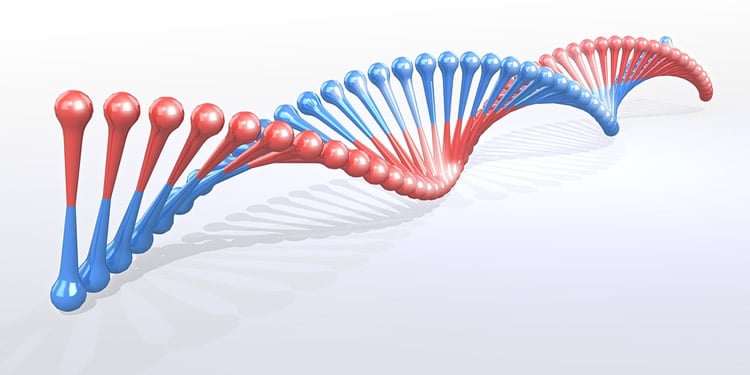Summary: Researchers genetically restored levels of the SynGAP protein in adult mice who were deficient. Restoring the protein levels resulted in improved memory and a reduction in seizures related to the SYNGAP1 disorder, a form of autism. Findings suggest it is possible to extend the window of treatment for those with this specific form of ASD, beyond infancy and into adulthood.
Source: Scripps Research Institute
A new study challenges the presumption that people born with developmental brain disorders such as severe autism will benefit from medical interventions only if treated during a narrow window in infancy or early childhood.
Writing in the journal eLife, an open-access scientific journal, the Rumbaugh lab at Scripps Research in Florida reports improvement in measures of seizure and memory in adult mouse models of a genetic cause of autism, called SYNGAP1 disorder.
Children born with only one working copy of the SYNGAP1 gene don’t make enough of the critical SynGAP protein. Two broken copies is lethal. Depending on the extent of their deficit, these children can develop a range of developmental challenges as they mature. This may include intellectual disability, autism-like behaviors, disordered sensory processing, and epileptic seizures that don’t respond to medication. The disorder likely affects one to four individuals per 10,000, similar to the frequency of Fragile X syndrome, says Gavin Rumbaugh, PhD, an associate professor in the Department of Neuroscience at Scripps Research in Florida. However, patients can only be discovered through genetic tests. As a result, only a small fraction of patients with this disorder have been discovered.
To study whether treatment of SYNGAP1 disorder in adulthood could be beneficial, Rumbaugh’s team genetically restored levels of the mice’s SynGAP protein to normal. The treated adult mice showed multiple improvements. It suggests that having one broken copy of the gene not only harms the brain as it develops, but it also has effects in the adult brain, Rumbaugh says. There may be reason to treat at any stage of life once options become available, Rumbaugh adds.
“Our findings in mice suggest that neurodevelopmental disorders’ disease course can be altered in adult patients,” Rumbaugh says. “We can correct brain dysfunction related to seizure as well as memory impairments after restoring SynGAP protein levels in the adult animals.”
Significantly, the paper offers a path to measure the effectiveness of potential medications or other therapies for neurodevelopmental disorders going forward. Electrographic spikes between seizures is an indicator of epilepsy. In their paper, the scientists looked at human EEG data collected from a SYNGAP1 disorder patient registry and found that the appearance of these spikes were much more likely to occur during sleep. Similar findings were observed from mouse models of SYNGAP1 disorder, offering a useful endpoint. Establishment of biomarkers that predict generalized improvements in brain function will be a critical step in advancing treatments for people with severe neurodevelopmental disorders, Rumbaugh says.

The need for a treatment option is clear, Rumbaugh says. Seizures typically become more frequent as children with SYNGAP1 disorders mature, and for many patients, those seizures do not respond to anti-epilepsy drugs.
“Getting to know families affected by this severe disorder has been invaluable, and drives us to develop treatments that will improve the lives of both children and adults,” Rumbaugh says. “It is encouraging that gene therapy techniques that increase pathologically low protein levels for other types of brain disorders are showing promise in the clinic now.”
Additional authors of the study, “Re-expression of SynGAP Protein in Adulthood Improves Translatable Measures of Brain Function and Behavior,” include first author Thomas K. Creson, Camilo Rojas, Thomas Vaissiere, Muratb Kilinc, and Courtney Miller of Scripps Research, Ernie Hwaun and Laura Lee Colgin of the Institute for Neuroscience at the University of Texas at Austin, and J. Lloyd Holder, Jr. and Jianrong Tang of the Baylor College of Medicine.
Source:
Scripps Research Institute
Media Contacts:
Stacey Singer DeLoye – Scripps Research Institute
Image Source:
The image is in the public domain.
Original Research: Closed access
“Re-expression of SynGAP protein in adulthood improves translatable measures of brain function and behavior”. Thomas K Creson, Camilo Rojas, Ernie Hwaun, Thomas Vaissiere, Murat Kilinc, Andres Jimenez-Gomez, J Lloyd Holder, Jianrong Tang, Laura L Colgin, Courtney A Miller, Gavin Rumbaugh. eLife. doi:10.7554/eLife.46752
Abstract
Re-expression of SynGAP protein in adulthood improves translatable measures of brain function and behavior
It remains unclear to what extent neurodevelopmental disorder (NDD) risk genes retain functions into adulthood and how they may influence disease phenotypes. SYNGAP1 haploinsufficiency causes a severe NDD defined by autistic traits, cognitive impairment, and epilepsy. To determine if this gene retains therapeutically-relevant biological functions into adulthood, we performed a gene restoration technique in a mouse model for SYNGAP1 haploinsufficiency. Adult restoration of SynGAP protein improved behavioral and electrophysiological measures of memory and seizure. This included the elimination of interictal events that worsened during sleep. These events may be a biomarker for generalized cortical dysfunction in SYNGAP1 disorders because they also worsened during sleep in the human patient population. We conclude that SynGAP protein retains biological functions throughout adulthood and that non-developmental functions may contribute to disease phenotypes. Thus, treatments that target debilitating aspects of severe NDDs, such as medically-refractory seizures and cognitive impairment, may be effective in adult patients.






